by Winding Pathways | Aug 16, 2018 | (Sub)Urban Homesteading, Energy Efficiency
Tested by Winding Pathways LLC
An independent review of the EGO Cordless Lawn Mower
A WOMAN’S PERSPECTIVE
Winding Pathways recently received a loan of an EGO Cordless Lawn Mower. For several weeks both Rich and Marion used it in the various ways we’ve used our gas power mower. These include conventional and some non-conventional ways we mow.
Just What Is a Cordless Mower

The EGO cordless lawnmower even has lights!
Electric mowers have been on the market for years, but they’ve been corded, meaning they have a long wire and need to be plugged into an outlet to function. They are quiet and low maintenance but have two disadvantages. First, they are only useful as far as the cord will reach. Second, the cord itself is both a trip hazard and a shock hazard. There’s the possibility that the mower could accidentally cut the cord, exposing the user to a hefty shock.
In contrast, the EGO mower is cordless. It operates on a 56-volt battery that is placed in a compartment on the mower deck. This modern lithium-ion battery packs plenty of power and runs for about 45 minutes before its depleted and needs recharging. There is no cord to tangle or cut. And, it even has headlights!
CORDLESS VS GASOLINE MOWERS
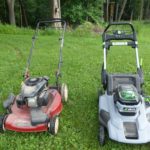
Comparison of a gas mower and the EGO cordless lawnmower.
For years we’ve used a conventional gas-powered mower on our 10,000 square foot conventional lawn. That’s about a quarter of an acre. We also use it to create pathways in our prairie labyrinth and through the prairie behind the house. Each fall we use the mower to grind up large prairie grasses and flowers.
We found the EGO as effective, or more so than the gas model for all our needs. It is truly amazing. Here are some positives to the cordless mower:
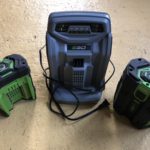
Batteries charge quickly.
RUNTIME: We ran it at least 45 minutes and it was still going strong. It took 40 minutes to completely charge a battery. That means if an owner has two batteries, one in the mower and one on the charger, mowing can be continuous. Or, when the battery is discharged but there’s more lawn to mow it’s a great time to enjoy a glass of ice tea while it charges!
NOISE: We are conscious of hearing loss from power tools and household equipment like blenders and vacuum cleaners. So, we use an app to measure noise. We compared the noise of the operating EGO mower with the gas mower. The EGO ran at 75 decibels. This is below the threshold where noise can create hearing loss. In contrast, the gas mower ran at 95 decibels, putting it in the hearing loss danger zone. We always wear hearing protection when using the gas mower but didn’t need it with the EGO.
There’s another great advantage to a quiet mower. Noise doesn’t respect property lines, and mowers create neighborhood noise pollution. Not the EGO. We doubt our neighbors would even know we’re using it.
MAINTENANCE: The Ego is a maintenance dream. Our gas mower requires us to store and add gasoline, check the oil periodically and change it annually, change the spark plug and air cleaner element annually, and clean the carburetor every couple of years. Because the EGO does not need gas and has no oil, air cleaner element, or carburetor it eliminates the maintenance need of a gas mower. Both gas and the Ego need two types of maintenance that include cleaning the mower after use and sharpening the blade occasionally.
USER-FRIENDLY: The Ego is user-friendly. Even with the fairly heavy battery installed it is lighter than our gas mower. Adjusting the length and angle of the bar the operator holds is a snap. So is adjusting the mowing height. Perhaps even better, the mower handle folds up reducing storage space needs. It could even be hung on a wall for winter storage as there are no liquids to drain out.
MARION’S PERSPECTIVE
Last year I injured my right shoulder pulling the gas mower cord trying to get it started. With the EGO, starting is a breeze: push and hold the button, lift up on the bar, listen for the soft whir of the blade and off you go! Goodbye rotator cuff problems!
Mowing the labyrinth with its several turns is a task and I was concerned initially about not having a self-propelled mower. It is not an issue because the EGO mower is lightweight and easy to maneuver. Also, the grass discharger or mulcher is within the width of the mower itself. No more concern about accidentally knocking off the attachment and breaking the small prongs that hold it in place. An additional advantage to the EGO is that it has one large, encased cord instead of several small ones that get snagged easily on shrubs. A very nice feature.
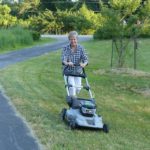
Women appreciate the ease of starting and moving the EGO cordless lawnmower.
After we were satisfied with the EGO, we invited neighbors to give it a try. They loved it for all the above reasons and, especially, the ease of starting the mower. Tom has shoulder issues and appreciated the easy start. He prefers the push mower as he has several retaining walls to negotiate around.
After tentatively starting off, a big smile spread across Sherrie’s face as she pushed the mower easily through the grass. She was impressed with the mulcher feature and how easy adjusting the height of the mower was.
We have found the EGO cordless mower more than satisfactory for personal, environmental and neighborhood relations reasons. Give it a whirl!
by Winding Pathways | Oct 5, 2017 | (Sub)Urban Homesteading, Energy Efficiency
(This story first appeared in the Cedar Rapids Gazette.)
A few months ago, my wife called me to her computer to view our electric bill. Although the weather had been mild the previous month we were still proud to see a $13.18 bill, or about 45 cents a day.
That’s a low bill for us but even when we figure in higher use during hot and cold seasons our monthly average bill is $38, or about 32% of the average $114 residential bill. Our medium size home has typical appliances and lights yet we annually pay Alliant Energy about $936 less than other families.
We’ve done nothing magical, and nearly any home following our strategy is certain to reduce their costs without sacrificing comfort or convenience. Here are gradual steps we took to save money and electricity.
First, we exercise the power of the human index finger. If it’s not in use, we turn it off. The sun provides free light and heat yet never sends a bill. In winter, we open south facing blinds to welcome the sun’s light and warmth and close them at sunset.
Second, we embrace technology. Incandescent bulbs are bygone era dinosaurs. Modern LED bulbs provide better light while consuming much less electricity. Although costly just a few years ago, now LED’s are competitively priced. We didn’t gradually replace incandescents. Instead we tossed out those still working to convert the whole house to efficient lighting. It was a bit of an “ouch” for Marion, who is a “Yankee of the “use it up, wear it out, make do our do without” philosophy. However, almost immediately our electric bill shrank enough to cover bulb costs. Savings will continue for years.
Third, when buying a new appliance, we purchase the most energy efficient model available, which generally wears the Energy Star logo. Old appliances are costly thieves. Efficient replacements normally cost slightly more than less efficient models, but utility savings quickly erase the difference. Efficiency is a wise financial investment.
With high efficiency in place our bill shrank to $55 a month, or just under half the average home’s cost. We wanted to do better so contracted with Site Gen Solar in Cedar Rapids to install a solar electric, or photovoltaic, system.
Just before the 2016 June summer solstice they installed a modest system and six months months later we received tax credits that dropped its cost nearly in half. Every day our photovoltaics convert sunlight into electricity. When we’re making more power than we’re using electricity runs our meter backward, enters the grid, and helps power neighboring homes. The photovoltaic system dropped our average bill to $36, and we’re enjoying an 11% return on our solar electric investment.
Efficiency and photovoltaics do more than reduce cost. They help us avoid burning coal and gas used to generate electricity. We have taken a positive step toward reducing climate change. It feels good.
During our quest to reduce cost we had a surprising partner – Alliant Energy. Alliant gave us information and financial incentives to buy less of their product. It’s an ironic position for a company. Imagine Exxon Mobile or Walmart doing the same! We are neither employees nor stockholders of the utility but appreciate their help.
Nearly every family can protect itself from increased cost and help the environment by using energy efficiently. Some can add photovoltaics to further cut cost. For information on how to receive a free energy assessment, rebates for efficient equipment, and several other ways of easily reducing cost contact Alliant. For anyone interested in adding photovoltaics the City of Cedar Rapids and Linn County are partnering a Solar Group Buy this year to reduce installation costs. To learn more access www.SolarizeLinnCounty.com.
by Winding Pathways | Feb 19, 2017 | (Sub)Urban Homesteading, Energy Efficiency
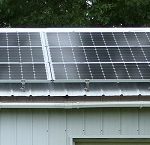
Sunlight hits our solar panels at a different angle in the fall and winter.
To: Robert Dix, Brad Duggan, and Lisa Henderson (all helped us with photovolotaic)
What we’ve learned from our PV System
This week our photovoltaic system has given us a great learning opportunity. We’ve now had several crystal clear days and the envision monitoring system clearly shows the electric production hour per hour. It’s fascinating to me to learn that our peak power comes at 12:30 p.m. and when I go out and look at where the sun is this is when it is precisely pointing at the PV system.
The PV system and the monitor have encouraged me to observe how the sun moves throughout the day and over the seasons. This education is a strong positive side benefit of PV.
by Winding Pathways | Oct 30, 2016 | (Sub)Urban Homesteading, Chickens, Energy Efficiency
One late October afternoon Rich brought only three eggs into the kitchen. In spring and summer our 15 hens normally give us a dozen beautiful eggs every day. Like so many signs in nature our chickens are telling us it is transition time.
We have lucky chickens. They enjoy good food, safe living space, and daily fresh air, sunshine, exercise and natural food. Seasons shape their lives, but even their unfortunate counterparts living in cramped cages in factory farms are not completely immune to seasonal changes of nature.

When molting chickens lounge, take dust baths, and re-grow new feathers.
A hen starts laying when she’s four to five months old and stays laving for 12 to 14 months. Egg laying is tough on bodies and after a year chickens need a vacation. So hens call time out. They shed old worn out feathers and grow new ones, rest and eat as they build back strength. After a month or two they look great in their new feathers and begin laying again – if they are fortunate enough to live in a backyard flock.
Commercial egg operations kill hens as they begin to molt and replace them with young birds. Not us. We keep our birds for at least two years. In their second lay cycle our hens give us slightly fewer eggs but they are huge with bright yellow/orange yolks in shells of various hues.
Molting is caused, in part, by the age of the bird, but declining daylight is a major factor. Nature has programmed chickens to lay the most eggs in spring. As fall’s days shorten production drops. We let our chickens enjoy seasonality. Commercial eggeries don’t. Their unfortunate hens live in windowless buildings with lighting that simulates spring to stimulate peak production.
Declining day length triggers thousands of reactions in our world outside the living room windows. Here are just a few things we notice:
-

A still day of reflection on Turtle Stump.
Leaves of our sugar maples turn vibrant red/orange before drifting to the ground like snow. Our black, white, and red oak leaves wait a bit later until turning rust colored and shedding, although some oaks keep dead leaves all winter.
- White footed mice, box elder bugs, and Asian beetles try their best to get into the house before cold weather settles in.
- There are comings and goings in the yard. We’ve said “goodbye” to house wrens, orioles, grosbeaks, warblers and many other birds but are delighted to welcome back juncos from their nesting grounds up north. Hawks, geese, and even pelicans pass overhead on their way south.
- The world sounds and looks different as humid summer air transitions into fall’s dryness. Colors are more vibrant in low humidity air, sound transmits more clearly, and late afternoon sunlight dances across tree trunks and drying prairie grasses.
-

Sunlight hits our solar panels at a different angle in the fall and winter.
We produce a bit less electricity from our photovoltaics because the sun isn’t shining as long each day, but peak production is earlier in the day than in midsummer
- Sitting outside on a bright autumn day lets us soak in the sun’s delicious warmth but it cools quickly as the sun drops. Then, we go inside to enjoy the warmth our wood stove provides.
- Clouds drift by and sunrises and sunsets are particularly colorful.
- Autumn and winter constellations enchant viewers and linger into the darker mornings. Because the temperatures are mild, star gazing is pleasant.
Fall is a beauty filled season. We encourage you to “Go outside and play!”
by Winding Pathways | Jun 18, 2016 | (Sub)Urban Homesteading, Energy Efficiency
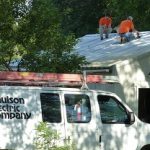
An excellent company to work with.
Just before the summer solstice Winding Pathway’s new photovoltaic system began producing electricity.
A few months ago Paulson Electric Company in Cedar Rapids, Iowa, did an analysis of our home and provided us with an airtight proposal. Thanks to tax credits from both the US and Iowa governments we could install a system that will produce about half our electricity without combustion, moving parts, or noise. We’ll receive at least a seven percent return on our invested money, better than we can do at any bank or the stock market.
Our system is net metered. Sun hitting the solar panels produces DC electricity that inverters convert to AC. It flows through our electric meter. When we are producing more electricity than we’re using, typically on sunny summer days, our meter runs backward. When we’re using more than it’s producing – at night and during winter’s short days – the meter runs forward. Each month we pay Alliant Energy, our utility, the net.
We love solar electricity. It takes some natural resources to construct and move the system but once in place it will last at least 25 years and continue producing electricity without burning fossil fuel or causing air pollution. And it saves us money.
Iowa is a national renewable energy leader with over 31% of the state’s electricity being produced by wind or solar. Within four years it will be around 40%. Our state isn’t alone. Solar and wind power are growing everywhere. They are a way for people to enjoy the benefits of electricity without worsening climate change.
The windmill graphic on my Iowa driver’s license is a fitting symbol for the energy revolution sweeping the state.
When conventional fuel prices spiked years ago Iowa leaders became concerned that vast amounts of money were leaving the state to buy oil, natural gas and coal.
Iowa may lack petroleum but has incessant wind and plenty of sunshine. Harnessing these limitless resources seemed prudent and governments, utilities, environmentalists, manufacturers and nonprofits converged to position Iowa into its current leadership role in renewable energy. “We had strong public policy and leaders like then governor Tom Vilsack (now US Secretary of Agriculture) who were interested in making it happen and worked with people to get it done. Wind manufacturing was a target for economic development. We added renewable energy training at community colleges and passed production tax credits to encourage small scale locally-owned wind and solar projects,” said State Senator Rob Hogg.
Today 31% of Iowa’s electricity comes from the wind and sun. It will likely reach 40% by 2020 propelled in part by declining costs of renewable installations. In 1983 it cost 55 cents to produce a kilowatt of wind electricity. Today it’s a nickel. Photovoltaic costs, although higher than wind, are also tumbling.
Iowa’s renewable energy boom arrived with little controversy. Farmers receive royalty payments for each turbine on their property and about 6000 Iowans are now employed in the wind industry assembling turbines, constructing and maintaining wind farms, and providing equipment to support the industry. So strong has employment grown that Kirkwood Community College in Cedar Rapids erected a massive turbine that produces 24% of its electric consumption and offers an Associate Degree of Applied Wind Maintenance. “Our graduates have been hired by many utilities and are now maintaining turbines all over the world,” said Tom Kaldenberg, Associate Vice President.
Van Meter Industrial is a wholesale electrical supply distributor. “Five years ago we had one employee serving the photovoltaic market. Now we have five. At least 47 Iowa companies are involved in the solar energy supply chain and at least 680 Iowans are employed in installing, marketing, and supplying the solar industry,” said Brad Duggan, Van Meter’s Renewable Energy Product Manager.
-

-
An excellent company to work with.
-
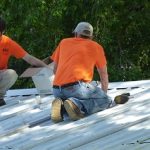
-
Workers begin on the roof installing the framework. They watch the weather for at least two consecutive days of low wind and no storms to complete this part of the job.
Renewable energy isn’t perfect and won’t completely replace conventional power generation. Calm occasionally envelops usually gusty Iowa and the sun refuses to shine at night. Wind turbines kill birds and bats, but this threat has diminished. Some people simply don’t like windmills, although I’ve heard few Iowan’s express this.
Wind and solar reduce the negative impact of burning fossil fuels. Once in place these renewables release no emissions to the atmosphere and don’t pull water from rivers or the ground. There’s no need for dams to block fish movement and no concern about a nuclear catastrophe or mercury and acid raining down into lakes and the ocean.
There are significant economic and legal differences between wind and solar electricity. Massive wind farms are owned by utilities and like coal or nuclear plants the utility produces and sells the power. To a consumer there isn’t any difference between buying electricity produced at a coal plant or wind farm. In contrast photovoltaics and the electricity they produce are owned by individuals.
Wind often blows all day and night, while the sun only works the day shift. To completely rely on solar electricity a homeowner needs a stand-alone system to charge batteries when the sun’s shining and yield electricity when it’s not. Battery systems are expensive and normally only cost effective if a home is a long distance from the grid.
Increasingly common are grid intertie net metered systems where electricity flows both ways through a meter. There is no power storage. Essentially the grid acts as a battery. When a home is producing more electricity than being used power flows outward to the grid, running the meter backward. At night electricity is pulled in and the meter runs forward. At the end of the month the utility bills the customer for the net amount used.
Over 20 years ago, while Director of the Indian Creek Nature Center, I acquired photovoltaic panels that Jimmy Carter erected on the White House and Ronald Reagan later removed and put in storage. I wanted to create Iowa’s first net metered photovoltaic system but there was no legal mechanism for a grid inter tie. Fortunately my utility, Alliant Energy, was cooperative and helped legally and technically connect the system with their grid. This led to a permanent legal mechanism that enables property owners to net meter either wind or solar generated electricity.
Although small our system cut the electric bill by 41% and the Nature Center is now constructing, with Alliant’s help, a new building that will produce more electricity than it consumes, a concept that can be incorporated into many structures.
-
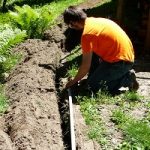
-
The wire is safely tucked inside this pipe.
-
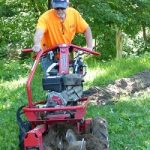
-
Trenching takes time and skill.
-
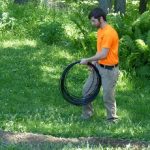
-
After the trench is dug, the coil is unwound and settled into the trench.
Because utilities don’t produce home or business generated solar electricity they face a dilemma somewhat akin to electric cars, where the owner uses roads but does not pay gasoline taxes needed to maintain them. Utilities must sustain their grid but can’t sell electricity they don’t produce. Essentially net meter customers have free access to the grid. Utilities are likely to eventually charge a grid access fee.
Economics are driving renewable energy expansion, at least in Iowa. Cedar Rapids based Paulson Electric recently prepared a bid to place a photovoltaic system on our home. For a cost of $13,150 a new system will produce 93% of our electric consumption. We will receive state and federal tax credits of about $6312, reducing our cash cost to $6838. The payback on investment is about 11.2%. That’s far more impressive than the microscopic interest we receive from our traditional investments.
Renewable energy isn’t pie in the sky but In Iowa it has created significant employment while reducing environmental threats caused by hydro, nuclear, and fossil fuel. It is a model that is expanding across the country and holds great promise for a cleaner future.
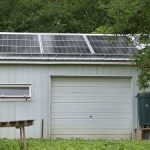
Soaking up the sun.
For information Contact
Wind: American Wind Energy Association at www.awea.org
Solar: Solar Energy Industries Association at www.seia.org
Solar Electric Power Association at www.solarelectricpower.org
Paulson Electric in Cedar Rapids at www.paulsonelectric.com
Van Meter Industrial at https://www.vanmeterinc.com/
by Winding Pathways | Feb 28, 2016 | (Sub)Urban Homesteading, Chickens, Energy Efficiency, Geology/Weather, Nature
How ironic that many homeowners don’t harvest the rain that falls on their property, yet they buy water to irrigate their lawn and garden. Harvest free water by using rain barrels and rain gardens.
RAIN BARRELS
Since ancient times families have captured rain falling on their roof to use for irrigation. It worked thousands of years ago and still works today. A rain barrel is a large container positioned under a gutter downspout to catch and hold water for later use. They can be homemade but most people prefer buying one. Hundreds of models are on the market and range from simple and inexpensive ones to elaborately designed barrels that are practical and decorative. We purchased ours from Rainwater Solutions and have placed six under the downspouts of two buildings. The free water irrigates our vegetable garden and provides water for our small flock of chickens. For more information see the Winding Pathways blog of April 2015 or check http://www.rainwatersolutions.com/
RAIN GARDENS
Rain gardens are more permanent than barrels. Like the barrels they range from the simple to the elaborate. Rain gardens aren’t used to harvest water for irrigation but channel roof runoff into the ground rather than into storm sewers.
Our rain garden is simple and cost nothing to create. We dug a shallow basin in the lawn about the size of a bath tub where our downspout discharges gutter water. During a light to moderate rain our rain garden absorbs all the roof water and puts it back into the ground where it moistens roots and eventually helps recharge the aquafer. During a fierce thunderstorm it overflows a little but we channel that to the lawn. Between the garden and lawn all the rain falling on our roof stays on our property, benefiting our plants and not creating flooding downhill.
The Indian Creek Nature Center and Linn County Master Gardeners will hold workshops in March 2016 to help participants learn how to make their own rain garden. Other nature centers, master gardener and Extension Offices hold similar workshops in many locations across the country. Books and websites are available to help homeowners plan their rain garden. One of our favorite information sources is the Low Impact Development Center.
Besides harvesting water and reducing downstream flooding there’s another benefit of having a rain garden. Flowering plants that require wet soil flourish in rain gardens but can’t live in nearby dry soil.













